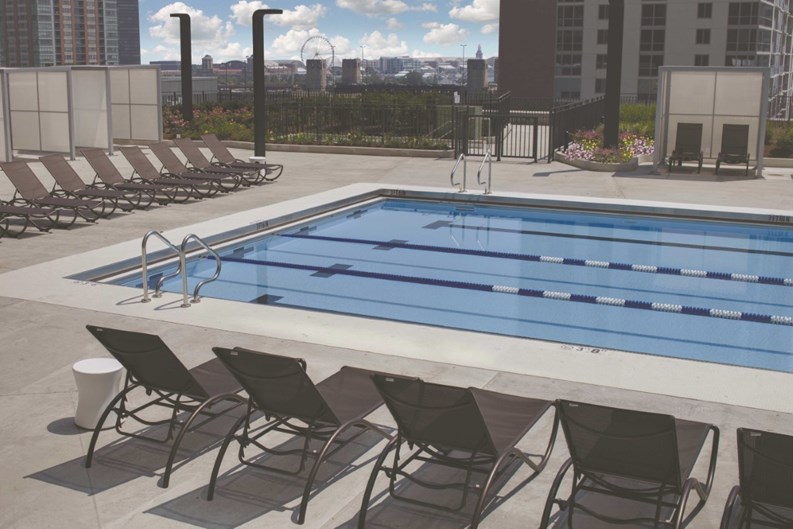It’s a different world for amenities, these days. Just a decade ago, if you were fortunate enough to live in a building with a gated entrance or a nicely-landscaped swimming pool, you thought you hit the jackpot. It was easy for the building or condo association too, because they simply had to water the lawn or add chlorine regularly, and the residents were happy.
If you had a health or fitness center in your community center, it contained some free weights and maybe a treadmill—and no one complained.
But those days of simple amenities are long gone. At a time when empty condos are a dime a dozen, and home prices are falling, technological advances and an increasingly sophisticated real estate consumer have prompted condominiums old and new—but especially new—to raise the amenities bar in order to attract buyers, increase value and preserve the importance of the building. From dog runs to playrooms for kids, from private media screening rooms to resident lounges with daily continental breakfast, condos and co-op buildings are taking it to the next level.
Not Necessarily New
Even during the housing recession that crippled Chicago and the rest of the United States, the amenities market was booming.
“They were using their amenities to grab more people instead of scaling back to save money,” says Arin Agase, marketing director for Chicago Signature Properties, a full-service luxury apartment finding and brokerage company.
Currently, a skimpy or run-down fitness room can be a deal breaker for a lot of buyers—it should include more than just a few mismatched hand weights and an old treadmill. It needs to be a pleasant, well-maintained room that contains all the basics you’d find in a nice gym: machines with individual televisions attached, at least one complete set of weights and space for a personal trainer to help you with your workout if needed. Some gyms are also adding room for a private Pilates or yoga teacher to come in a teach classes for the entire building.
But the most popular amenities right now for a standard building are a basic outdoor pool, sundeck sauna, hot tub and party room. Some of the more creative and upscale buildings are even adding indoor basketball courts, movie theaters, outdoor tracks and an indoor pool, Agase says.
Heated Competition—and Pools
As the competition for condos and co-ops increases, associations are becoming increasingly savvy when it comes to adding amenities, says Sheldon Salnick, a Chicago-based real estate blogger and agent with Rubloff Residential Properties.
“Everything you can think of is available now,” Salnick says. “A lot of the buildings are looking to New York City for trends, because sophisticated buyers are moving to Chicago from the East Coast, London, Singapore and Canada.”
And these new high rollers have specific requests.
Dog walking, 24-hour room service from local hotels and restaurants, private chefs, full-service concierge services, spas, high-end business centers and enhanced privacy are some of the new demands that are becoming amenity trends.
Whereas in previous years, a small room with two computers and a printer would classify as a business center, some of today’s buildings are outfitted with computers, fax machines and even people to help you create corporate presentations.
And some buildings are doing whatever they can to stand out from the others.
The Aqua, a mixed-use tower at Lakeshore East in Chicago calls itself “The Shore Club.” They have two floors of outdoor and indoor entertainment and recreation, and boast that the building contains the largest outdoor pool and amenity deck in the entire city.
Aqua has an 80,000-square-foot landscaped deck that features a sundeck, gardens, running track, swimming pool, hot tub, gazebos, poolside cabanas, fire pit barbecue areas and wireless Internet.
Inside, Aqua has a 35,000-square-foot amenity floor containing fitness facilities, a basketball court, group fitness studio, indoor lap pool, hot tub, spa, sauna, steam room, massage rooms, private club suites with catering kitchens, a sky garden lounge, media room, billiards and game area and a business center with a conference room.
“Small wonder that every time you step into The Shore Club at Aqua you’ll feel like you’re on vacation,” says David Carlins, president of developer Magellan Development Group, which is in charge of Aqua.
I Want to Be Alone—and Order Room Service
The ultimate in amenities—privacy—is becoming a more common offering too, Salnick says. “A lot of home buyers want privacy, especially when they’re well-known or are chairmen,” he says. “Some people don’t even like the idea of other people going to their floor.”
So some buildings have added a keyed system to their elevators that only allows residents with a key access to their floor. Other people living in the building can only go to their floors too.
At 50 Chestnut in Chicago, each apartment takes up an entire floor, so you can be assured that no one will be trespassing in your hallway.
Other buildings are combining forces with hotels so that their amenities simply feed off the hotel’s normal perks.
In Chicago, the Trump, Drake and soon-to-be Ritz Carlton residences will up the bar when it comes to residential amenities.
At the Drake, unit owners will have access to the Drake Hotel's business center, valet parking garage, hotel lounge, expansive lobby, ballrooms, bellmen and hotel restaurants—which will leave few reasons for actually leaving your building.
And at the Trump International Hotel & Tower Chicago, residents get a 24-hour white glove doorman, full service concierge, 24-hour room service, designated parking, access to the Trump Spa and Health Club, storage lockers, in-home dining and catering services, dry cleaning and laundry valet, housekeeping and access to Trump’s Sixteen restaurant, hotel banquet and meeting rooms.
The Ritz-Carlton Residences, which are expected to open early in 2012, will contain homes ranging from large one-bedrooms to penthouses reaching more than 6,500 square feet. Prices will start at $1.25 million.
Amenities will include a full-floor private club for residences and their guests. The club will have a grand salon, private dining room, billiard room, wine cellar, screening room, state-of-the-art exercise facility and spa.
At What Price, Fabulousness?
While amenities are a great way to show off your building, make residents happy and draw in new buyers or renters, they also always come with a price—to the residents and to the buildings.
A two-bedroom home at the Drake residence that was available in March includes all the promised amenities. It also includes an assessment of $2,755 per month, which is much higher than average in Chicago, where assessments for a two-bedroom in the Gold Coast area typically go for closer to $1,800 per month.
Still, many people are willing to consider the price in light of the benefits. One Chicago resident commenting on the popular Chicago real estate blog Cribchatter.com wrote this about his former residence at the Drake: “There is nothing like getting up on a day when it is 100 degrees and not having to walk outside for coffee or lunch. Also, you can meet your guests in the lobby, have a drink in the lounge and talk downstairs without having them come up to your place. You don’t get claustrophobic, because the lobby and lounges are so expansive. You also have access—allowed or not—to all of the ballrooms. There were many afternoons that I would sneak into some of the expansive rooms overlooking the lake, bring a book, find a chair and read. You can almost imagine the whole place being yours.”
For the buildings that are older or don’t have room for a ballroom, indoor pool or entire basketball court, there are other amenity options that won’t cost the association millions, Salnick says.
For example, the first thing people see when they walk into a building is the lobby. Fortunately, you can make a few cosmetic changes to really make it a lovely place to walk through and even sit for a few minutes.
“You have to bring the lobby up to 2011 standards,” Salnick says. “It has to be gracious, and the carpeting, the décor and everything else has to be there.”
Adding new gym equipment to an existing fitness facility will also draw in the 25-to-35-year-old crowd, he says. Taking a small room and turning it into a media room with a pull-down screen for movies, a host of computers, fax machines, Xerox machines and PowerPoint material will also be a good investment for older buildings. Associations can also add wireless Internet and a few comfortable chairs and useful tables to the lobby to make that area more appealing as well.
“Lincoln Park West in Chicago, which has one of the biggest, best gyms in the city, is an older building that attracts a younger crowd because they want the gym,” Salnick says.
Those changes will cost the association money upfront, but won’t require too much extra upkeep—as opposed to something like a pool, which will add much more in terms of insurance costs, building maintenance fees and then assessment costs.
Amenities Equals Appeal
While the real estate industry continues to flail in many markets—including Chicagoland—it may be well worth it for both developers and current building and HOA administrators to carefully consider their community's amenity offerings. What are their target buyers really looking for? Are existing spaces and amenities being fully utilized? Could they be updated or overhauled? Coming up with the right answers for your individual community can add value, even in the toughest of markets.
Danielle Braff is a freelance writer and reporter living in Chicago.





Leave a Comment